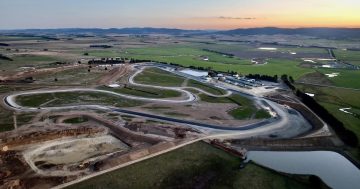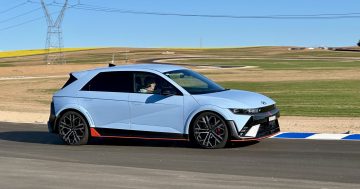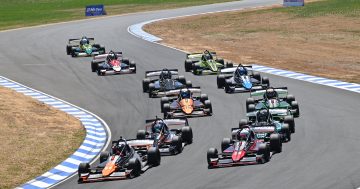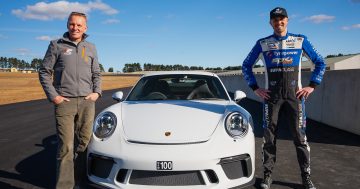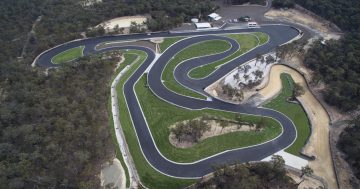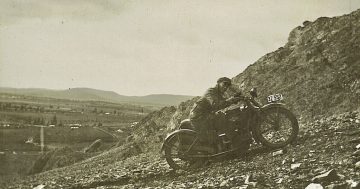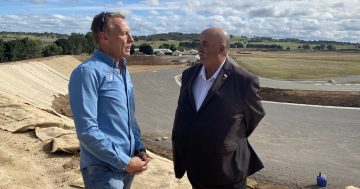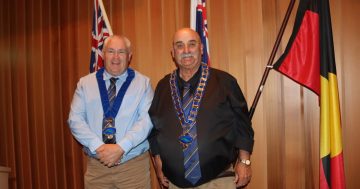
Atop an 11-metre-high noise wall some people have likened to Uluru, One Raceway owner Steve Shelley talks to Goulburn Mayor Peter Walker about the bright future of motor racing centred on the city. Photo: John Thistleton.
Goulburn’s revitalised racing circuit One Raceway will not be relying on major events for its ongoing viability when it opens this May, but in providing a solution for NSW’s alarming road toll through driver training.
One Raceway owner Steve Shelley said on Thursday (8 February) a new calendar would be restricted to 26 ‘red-scale’ events annually to provide plenty of respite from noise for neighbours in between the major meetings.
Noise breaches and excessive events caused the former Wakefield Park circuit to close in 2022, now One Raceway is relying on giant noise walls on the circuit’s north and south ends, and scaling down to amber and green events to enable viability within legal restrictions. This is self-imposed in consideration of neighbours.
But its big blockbuster super bikes event planned for October will bring back a roar and surge of excitement to the circuit south of Goulburn.
“We are really excited such a prestige event is coming back to Goulburn,” Steve said. Super bikes draw tens of thousands of spectators, and bring enthusiasts from as far afield as Perth, Darwin and Melbourne, he said.
Despite the bikes’ widespread appeal, other less noisy events are needed to strike the right balance to maintain operational viability. So One Raceway is talking to Goulburn Mulwaree Council and other stakeholders about future driver training courses.
“We are passionate about junior driver training,” Steve said. “The area between Camden and Canberra has a very unfortunate statistic of 12 per cent higher than the state average of road deaths. We think we can play a significant part in reducing the culture associated with the reason that happens.”
Longer term he would like to see junior driver training added to the school curriculum.
In the meantime, One Raceway has spent $7 million, and expects this will increase to $10 million and up to $15 million revitalising the circuit with nation-leading noise controls.
“One of them, we are using the atmospheric conditions and direction of the wind to dictate the way we will be operating, whether clockwise or anticlockwise,” Steve said. He knew of no other course like it.
“If we have a nor’easter like we’ve got today, we’ll probably run anti-clockwise which will allow us to control the way the sound is emanating across the valley. If we have a westerly, we will run clockwise.”
Consequently, each turn will have a name, rather than a number so they can be described when events are racing in either direction. The first turn to be named is ‘Slingshot’, so named because it allows drivers to break heavily getting into it and accelerate hard coming out.
Another improvement is the track’s sloped design. “Virtually anywhere you stand around this circuit, you can see all of the racing and no other circuit in Australia can say that,” Steve said.
The two large hills on either end created by earthmoving contractor Divalls which has moved more than 1,600,000 tonnes of soil, include tiered sections which will accommodate 3000 people on each hill for superb viewing.
One Raceway is addressing what Steve describes as an enormous amount of maintenance debt left by previous owners by building tens of kilometres of drainage works including culverts, pits and new dams. Asphalt will go down in March.
Steve will remind Premier Chris Minns in a meeting next week of the NSW Government’s promise of $1 million to help reopen the raceway. He will also raise with the government boosting power infrastructure so One Raceway can host electric vehicles.
Previous economic estimates reckoned Wakefield Park contributed anything from $17 million to $30 million to the Goulburn economy.
Goulburn’s Mayor Peter Walker said 27,000 submissions during the circuit’s uncertainty, to promote the circuit rather than close it were indicative of what it meant to the wider community in NSW and Australia.
Steve described a previous ‘wobbly moment’ when residents were not respected, or listened to which created a dispute which escalated. These days One Raceway had a heartwarming relationship with neighbours, including 40 people who gathered at a recent barbecue where presentations were made to him and his team, thanking them for revitalising a dead circuit.
“That doesn’t really happen in Australia,” he said. “When a circuit passes away it stays dead. But we have been fortunate to have the community support and from the council to be able to revitalise and rebuild this circuit.”







